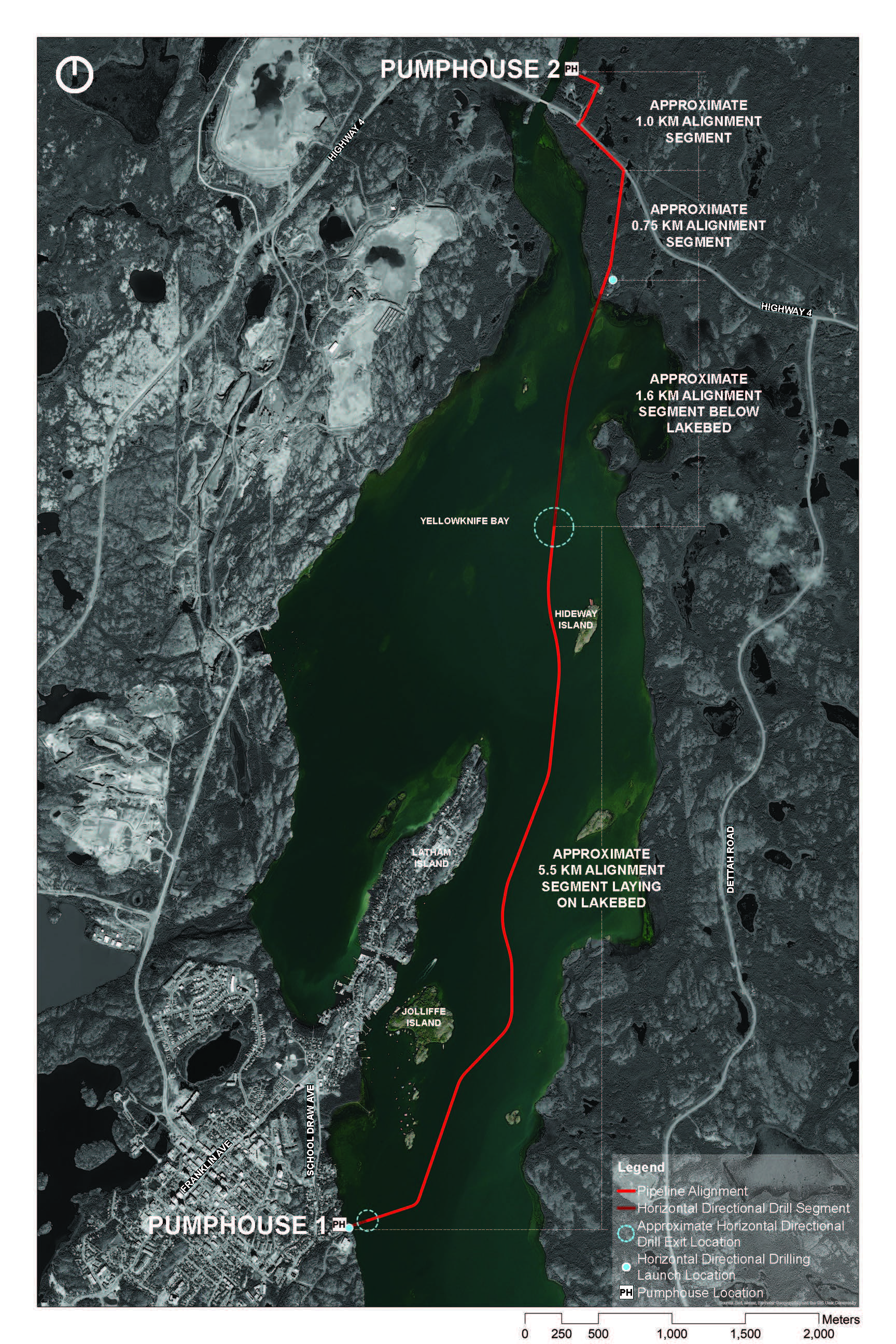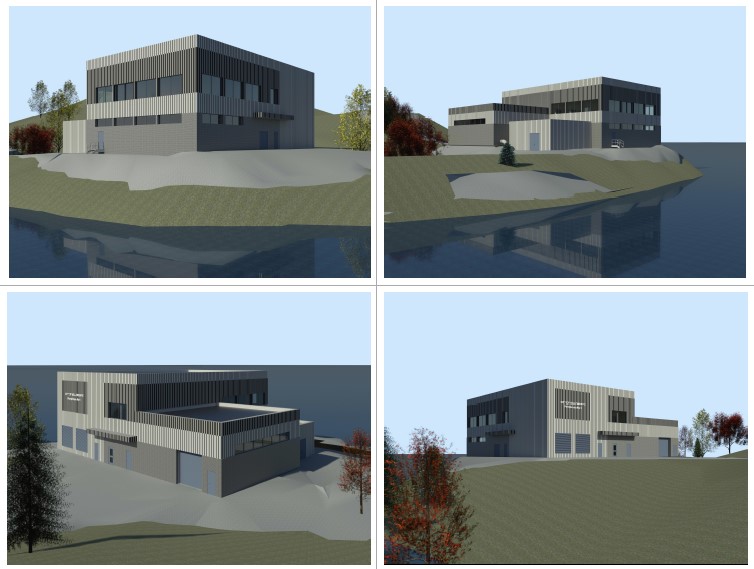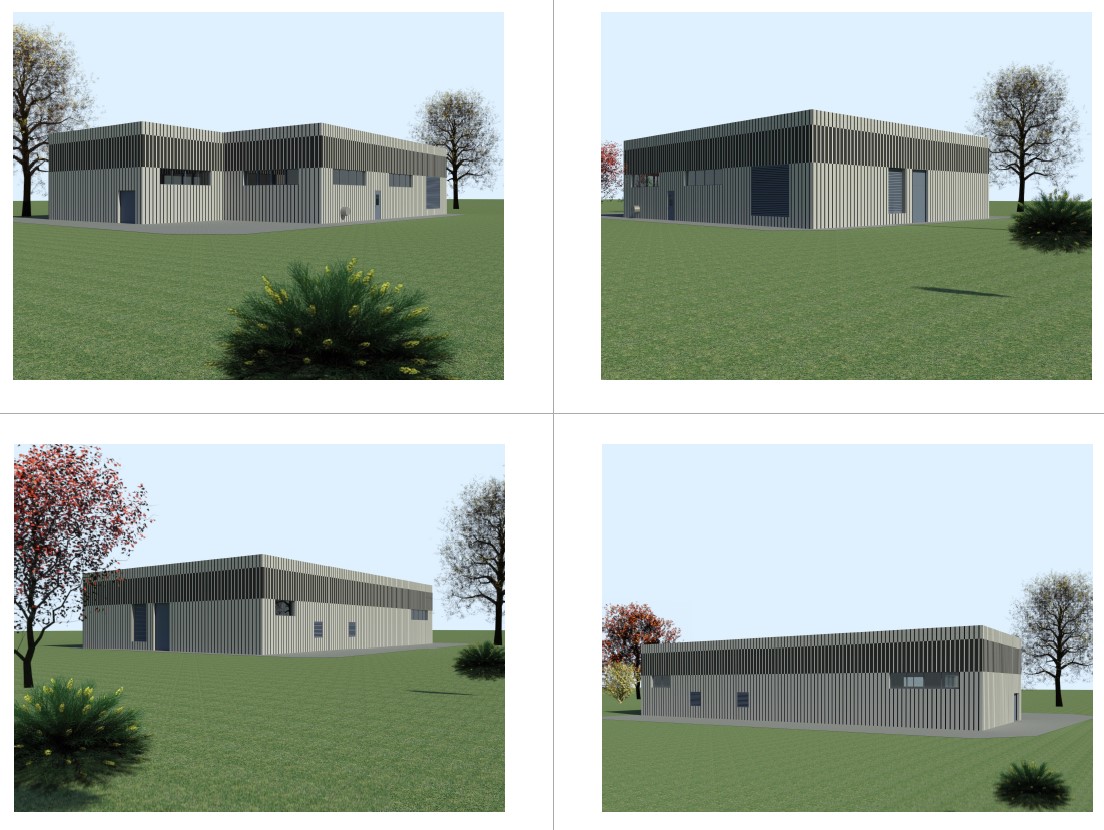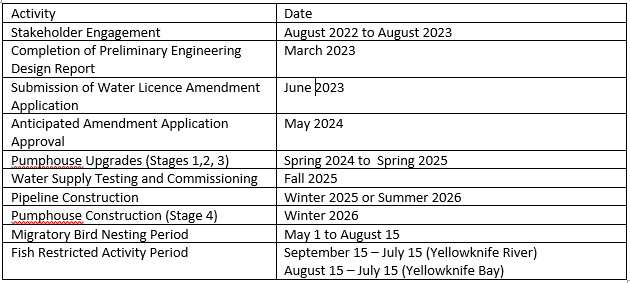Project Overview:
The City of Yellowknife is replacing the pipeline that supplies drinking water to residents. This pipeline currently runs underwater from the mouth of the Yellowknife River at Pumphouse No. 2, along the bed of Yellowknife Bay, to Pumphouse No. 1 located adjacent to the Water Treatment Plant.
A new pipeline ensures the City’s future water needs can be met and that drinking water supply is better protected during extreme weather.
The City assures residents that clean, municipal water will be readily available for use during this project.
What's New
AECOM has submitted a water licence amendment application to the Mackenzie Valley Land and Water Board (MVLWB, MV2021L3-0003) and a new land use permit application. The applications are required to draw water from local waterbodies and to deposit waste in a manner that is environmentally regulated, as well as undertake land use activities (like using heavy machinery, clearing land, and constructing buildings) associated with the project. As part of this project, the preliminary engineering design has been completed, and can be viewed by visiting the MVLWB registry.
City of Yellowknife - MV2023X0020 | Mackenzie Valley Land and Water Board (mvlwb.com)
As part of the Water Licence Amendment Application process, the below existing supporting plans are reviewed and updated.
- Spill Contingency Plan
- Waste Management Plan
- Erosion and Sediment Control Plan
These documents are in draft form and will be revised upon review by the Mackenzie Valley Land and Water Board, and when design/construction details are established.
Public Open House
The City of Yellowknife hosted a Public Open House on November 2, 2022, at the Explorer Hotel Katimavik A Room to discuss the Submarine Water Pipeline Replacement Project. City staff and members of the AECOM team gave a presentation on the project, as well answered questions from residents.
November 2, 2022 Open House Presentation.
November 2, 2022 Open House Handout (accurate as of November 2, 2022).
Frequently Asked Questions:
| Where does our water come from today? |
| Since 1969, the City’s primary water source is the Yellowknife River. The City draws its municipal drinking water from the Yellowknife River. Water is transported by an underwater line to the City’s Water Treatment Plant (WTP) on the shore of Yellowknife Bay. Water is treated and tested before making its way to residents of Yellowknife, Ndilo and Dettah via underground water mains, water trucks, or summer aboveground water lines.
The water treatment process uses a series of membranes that trap particles and contaminants as the water moves through them. After this filtration, the water is chlorinated to neutralize remaining impurities, and fluoride is added. The City’s current municipal water licence allows for use of up to 4,000,000 cubic metres of raw water annually, equivalent to an average raw water use of 10.96 ML/day (127 L/s). The City also draws a limited amount of water from Yellowknife Bay for maintenance and emergency purposes only. The City is authorized to withdraw a maximum of 300 cubic meters a month. |
| Why is the City of Yellowknife replacing the pipeline? |
| The existing underwater pipeline currently draws water from the Yellowknife River. It was built in 1969 and is nearing the end of its use. A new pipeline will better protect the drinking water supply during times of extreme weather. A new pipeline will also help ensure the City’s future water needs will be met. |
| What will the project entail? |
| The City is replacing the pipeline that supplies raw water to the City which ultimately provides drinking water to residents. This water line runs underwater from the mouth of the Yellowknife River at Pumphouse No. 2, along the bed of Yellowknife Bay, to Pumphouse No. 1 located adjacent to the Water Treatment Plant.
A new water supply system will include a new 600 mm submarine pipeline and upgraded pumps in Pumphouse No. 1 and No. 2. The pumphouse buildings and related systems must be upgraded to accommodate the increase in pipe diameter and to modernize the aging facilities to ensure a reliable and safe drinking water system. Project activities entail various areas of study, engagement, construction, and decommissioning, including:
The project has included various engagements processes for the land use permits and water licence amendment applications required by the Mackenzie Valley Land and Water Board (MVLWB). Engagement will continue for the life of the project, as required by the MVLWB. |
| What is the proposed pipeline replacement route? |
|
The proposed pipeline route runs from Pumphouse No. 2 along the Pumphouse No.2 Road, crosses Highway No. 4 and continues approximately 1.0 km along the Highway No. 4 right-of-way. From this point the pipeline route deflects into the forested area south of Highway No. 4 where, near the Yellowknife Bay shoreline, the pipeline would be installed via trenchless horizontal directional drilling (HDD) method and run below the lakebed for approximately 1.6 km south of the drilling launch point into the deeper waters of the Bay, north of Hideaway Island. From here, the remaining 5.5 km will lay on the lakebed as the proposed alignment continues east of the existing line from Hideaway Island to Joliffe Island to avoid a ridge along the bed of Yellowknife Bay. The final portion of the proposed alignment route then parallels the existing waterline from Joliffe Island to PH1. |
|
Why was this water supply pipeline route chosen? |
|
The selected water supply pipeline replacement route is an opportunity for the City to optimize the alignment. This route was chosen because of new information about the lakebed (bathymetric data) and to avoid environmental challenges that come with maintaining the existing alignment in shallower water and close to the mouth of Yellowknife River. This selected route observes the following alignment principles:
|
|
Why is the horizontal directional drilling (HDD) method being used? |
|
Horizontal Directional Drilling (HDD) is a proven method to install High-Density Polyethylene (HDPE) pipelines. Because HDD does not involve digging (trenching or dredging), it is particularly useful in areas that are environmentally sensitive, such as shorelines. HDD can greatly reduce excavation and rehabilitation costs associated with pipeline installations. HDD involves the following general steps: 1. Drilling a pilot hole from the launch point to the desired exit point along a predetermined path. 2. Widening (reaming) the pilot hole so there is a drilled opening slightly larger than the proposed pipeline. 3. Pull the pipeline back through the borehole. |
| Where will the new pipeline take water from? |
|
Once built, the new pipeline will continue to draw water from the mouth of the Yellowknife River. In 2017, the City of Yellowknife commissioned a comprehensive engineering study (Potable Water Source Selection Study) to look at the costs and risks of two water sources: the Yellowknife River and Yellowknife Bay. This study was completed by AECOM Canada Ltd (AECOM). AECOM recommended that the existing underwater pipeline be replaced, and confirmed that the Yellowknife River is the preferred option for the City’s water supply over the long term. The Yellowknife River option was chosen because it reflects public feedback heard during discussions on the new Yellowknife Water Treatment Plant in 2010 and 2011, and in the 2020 MVLWB water licence renewal process. Throughout, residents, regulators, stakeholders, and Indigenous governments underscored the importance of drawing water from the mouth of the Yellowknife River. Public and stakeholder feedback heard during pre-design project engagement (Fall 2022 – Winter 2022) confirmed drawing water from the Yellowknife River continues to be a priority. Information on public engagement conducted to date can be viewed as part of the water licence amendment application (Appendix I). Arsenic contamination of Yellowknife Bay from a major failure of the nearby Giant Mine site has a low probability of happening but is still considered plausible. Although Yellowknife Bay water is safe to drink, meets drinking water guidelines, and taking water from the Yellowknife River will cost more, drawing water from the mouth of the Yellowknife River ensures reliable, long term water supply. Dillon Consulting Ltd (Dillon) completed a third-party review of AECOM’s study in 2018. Both professional engineering companies recommended that the City of Yellowknife maintain Yellowknife River as the drinking water source and replace the submarine pipeline right away. |
| Will water from Yellowknife Bay be used during this project? |
| Yes. The Yellowknife Bay will be the raw water supply source during upgrades of Pumphouse No. 1. It will take approximately six to twelve months to replace the existing Pumphouse No.1 with a new building and equipment.
The existing Type A Water Licence authorizes the City of Yellowknife to withdraw a maximum of 300 cubic metres per month from Yellowknife Bay for maintenance purposes. To upgrade Pumphouse No.1, an amendment to the existing Water Licence is needed for temporary withdrawal of water from Yellowknife Bay and to supply drinking water for the City of Yellowknife. Water from Yellowknife Bay is only used for maintenance and emergencies. Maintenance includes regular start-up and inspection of the intake pump at Pumphouse No.1. emergency scenarios include things like a leak in the existing pipeline that would force it to be shut down for repairs, or a major fire that would need a large volume of water to put out. Water taken from Yellowknife Bay is always tested for arsenic before water is used. Maintenance is not done if arsenic concentrations are more than the Maximum Allowable Concentration (MAC) from Canadian Drinking Water Guidelines for Arsenic (0.01 mg/L). In the case of emergencies, risk management principles would be applied, and regulators notified. Water at intake points from both water sources is tested monthly for arsenic and other compounds. Not all aspects of the City’s water and waste services are regulated by a water licence. For example, drinking water quality is regulated by the Department of Health and Social Services under the NWT Public Health Act. This is not part of the water licencing process. |
| Is the water from Yellowknife Bay safe to drink? |
|
The water in Yellowknife Bay is tested on a monthly basis and is safe to drink. Since 2005, testing of Yellowknife Bay water at the intake of Pumphouse No.1 has indicated that it meets the standards outlined in the Guidelines for Canadian Drinking Water Quality. The Chief Environmental Health Officer and Chief Public Health Officer are satisfied that water drawn from Yellowknife Bay is safe to use for drinking water purposes. The Office of the Chief Public Health Officer confirmed this in the City’s application to draw water from Yellowknife Bay in March 2018. The City is very lucky to have two viable, high quality sources of drinking water. |
| Why is the City seeking a Water Licence Amendment? |
|
The City received its new water licence May 31, 2022 after public consultation in 2020 and completing the Mackenzie Valley Land and Water Board (MVLWB) renewal process in 2021. Under the NWT Waters Act, the City requires a “Type A” licence to draw water from local water bodies and to deposit waste. During the Type A Water Licence renewal proceedings, the City of Yellowknife said it had plans to replace the ageing underwater line. Now the City is applying for an amendment to this licence to do work required for the pipeline replacement. More information on the 2020 water licence renewal is available here. |
|
How will the pipeline be built? |
|
Construction methods will be based on the Project schedule and seasonal and environmental restrictions. Methods for open water and on-ice construction, as well as techniques for shore crossings, trenchless (Horizontal Directional Drilling, or HDD), and overland pipeline construction are detailed in the Water Licence Amendment application. Proposed construction methods are subject to change and will be determined by the Contractor based on specific site conditions. In all cases, the City is committed to best management practices. Methods outlined in the City’s permit application are based on best management practices. |
|
What changes will be made to the Pumphouses? |
|
The City’s two pumphouses – Pumphouse No.1 (PH1) and Pumphouse No.2 (PH2) – buildings and ancillary systems will be upgraded to increase their service life and reliability. Pumphouse 1 The PH1 building footprint will be expanded slightly to accommodate upgraded equipment, and the driving area surrounding PH1 will also be expanded to support additional parking and facilitate access for vehicles. A second floor will be added to the building to accommodate the areas such as offices, employee spaces and building mechanical equipment. PH1 construction will be phased as City water demand increases and to manage the transition to the new equipment.
Figure 1 - Rendering of Preliminary Design, Pumphouse 1 (PH1)
Building upgrades will include modifications to the main floor, such as a new booster pump room that replaces the current administration area, boiler, electrical and generator rooms, accessible washrooms and storage/workshop areas. There will also be upgrades to PH1 site so that the access road and driveways have a more manageable grade and width to support maneuverability, operations, and parking.
Pumphouse 2 PH2 will be expanded to make more room for process equipment, electrical, boiler, mechanical and generator rooms. New pumping equipment, piping, valves, and air handling equipment will be added. After construction, the site will be regraded and gravelled so there is proper drainage. The expanded PH2 area will be 0.23 ha.
Figure 2 - Rendering of Preliminary Design, Pumphouse 2 (PH2)
|
|
When will the pipeline be built? |
|
Construction will be done in phases, and could occur in the summer or winter months, through Spring 2024 – Winter 2026. Construction planning will consider things like feedback gathered from affected parties, regulatory requirements, construction requirements, supply of materials, seasonal construction windows, useable winter ice, open water, and the need to ensure ongoing water supply to residents. |
| What will happen to the old pipeline? |
|
The current pipeline is proposed to be left in place. This approach will cause the least amount of disturbance to the bed of Yellowknife Bay. Any spur lines will also be left in place. The waterline will be cut and capped on land at both pumphouses. |
| Will pipeline construction disturb the sediment in Yellowknife Bay? |
|
It is expected construction activity will create localized disturbance to lakebed sediment as the pipeline settles. Disturbance will be for a short time, and construction methods that limit disturbance, such as Horizontal Directional Drilling (HDD) will be applied. |
| How will the project affect traditional hunting, fishing, gathering or other traditional activities? |
|
Yellowknife Bay (Wıìlıìcheh) is a sacred harvesting area for the Yellowknives Dene First Nation, critical for traditional land use, gathering, and spiritual practices. For centuries, the YKDFN have used the Bay to travel and access other areas.* The mouth of the Yellowknife River (Wıìlıìdeh), has long been a dwelling place and where Treaty was often taken, and continues today to be an active cultural gathering site. Throughout the project planning and construction, the City will work closely with the YKDFN to identify and minimize disturbance to sacred areas and places of historical significance, as the route is planned and construction begun. For instance, during on-land construction of the pipeline from Yellowknife Bay to PH2, the City will work to minimize disruption to the Weledeh Gathering Area access off Pumphouse No.2 Road and the Yellowknife River Territorial Day Use Park access off Highway No. 4. However, some temporary restrictions should be reasonably expected during construction in this area. *Trailmark & DownNorth (October 2020). Summary of Research on the Establishment, Administration and Oversight of the Giant Mine and its Impacts on the Yellowknives Dene First Nation. |
| Who is paying for the pipeline replacement? |
|
On March 13, 2019, the Government of Canada announced that Yellowknife was a successful applicant to the Disaster Mitigation and Adaptation Fund (DMAF) program and would receive funding of $25,862,218, which represents 75% of the total project costs. The City received a letter from the Minister of Infrastructure and Communities stating approval-in-principle for the project. The remaining $8,620,740 cost of the project will be funded by the City of Yellowknife. |
|
How much will this project cost? |
|
The current cost estimate for the project is approximately $57,000,000. The COVID-19 pandemic and global instabilities have had unprecedented impacts on the world’s economy. The resulting supply chain costs, delays and labour shortages have contributed to rising construction costs in Yellowknife, and across the world. The City of Yellowknife continues to manage the project costs while ensuring critical infrastructure is in place for residents, today and tomorrow. |
| How will the pipeline impact remediation activities at Giant Mine? |
|
The City is an ongoing partner with Indigenous, Federal and Territorial Governments, regulators and affected parties on the Giant Mine Remediation Project. We remain committed to ongoing monitoring and evaluation to ensure the safety of northerners and the environment at the Giant Mine Site. We will continue to work closely with the Giant Mine Remediation Project as the pipeline project progresses, promoting transparency and sharing information about pipeline design, construction, and ongoing monitoring. |






